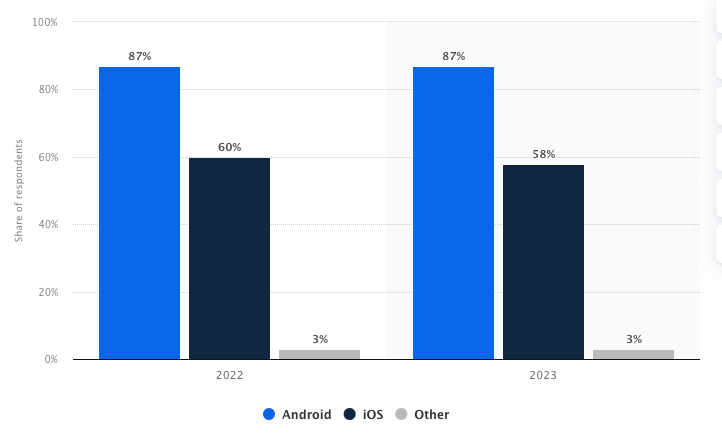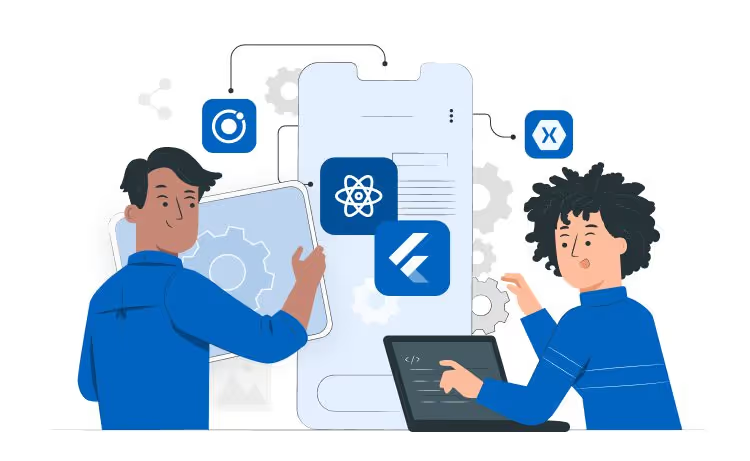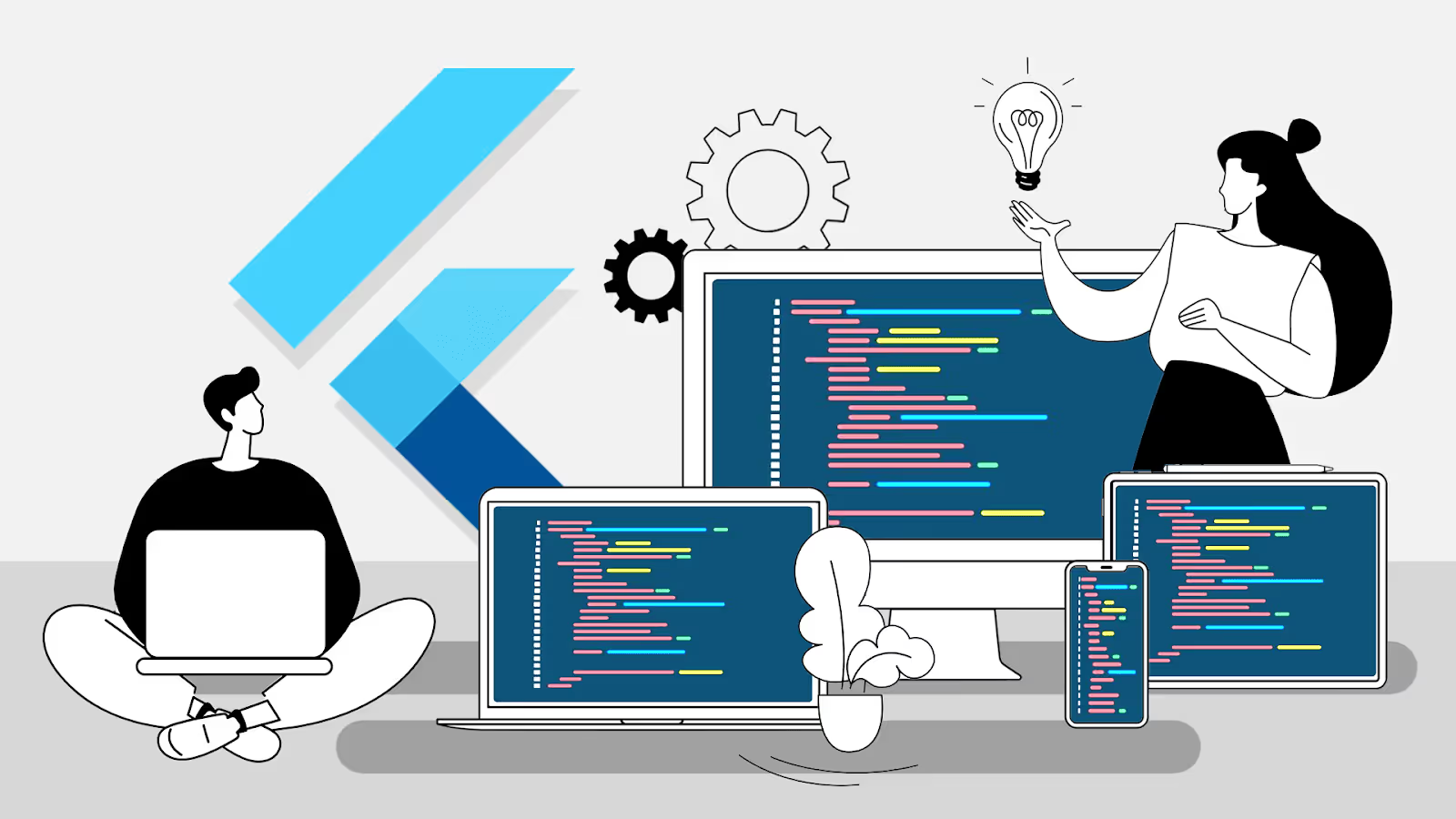
Explore cross-platform mobile development, compare it with native apps, and discover top frameworks for building scalable iOS & Android apps.

87% of mobile software developers worldwide are building for Google Play, while 58% are building iOS for App Store. This gap shows the development challenge of covering both ecosystems efficiently. Instead of maintaining two separate apps, cross-platform mobile development allows you to create iOS and Android apps from a single codebase, using one programming language. The result: faster launches, lower costs, and easier updates.

In this guide, we’ll explore why cross-platform is gaining momentum, how it compares to native development, and review the best cross-platform mobile development frameworks 2025.
Cross-platform app development is an approach that uses cross-platform programming languages and mobile app development frameworks that enable developers to create mobile apps that run on both Android and iOS. This eliminates the need to build a separate app infrastructure for both platforms, because you can create the two versions from only one codebase.
It's different from native development because in this approach, developers create separate apps for each platform, which often results in slightly different designs and functions. That's not handy for the user, you'll agree. Cross-platform custom mobile app development is popular due to time savings, cost efficiency, and development resources.

Native development sounds like the safest option, but it's not efficient in terms of cost and manpower. There are several benefits of cross-platform app development over native.
Without the need to develop two separate versions of the mobile application, you will be able to cut the development time by about 40% compared to native app development, leaving more time for refining business logic. As a result of the optimized development process, your mobile app development will be much faster, and your product will see the light of day much sooner. If you're also working on a website, it's worth learning how to outsource web development to keep things moving quickly and cost-effectively. This means your users won't have to wait long to enjoy your app.
Using a flexible development framework like Flutter will be much more cost-effective than hiring two separate teams for two different versions of the app. With a couple of specialists, you will be able to build two versions at the same time without double-maintenance of two product versions. If you're not sure where to start, it helps to understand how to hire mobile app developers who know their way around cross-platform tools. This way, you save money that you can use for other important things.
With cross-platform app development, you don't need to figure out twice the platform-specific features to implement, because if you implement them once on the Android version, you will have to create them for iOS. Also, during the development process, some features turn out to be not twins, but cousins to one another. As a result, you have features here or there that are not functioning in the same way on both versions of the app, which is not so good for a seamless user experience.
If you're building an app that needs strong visuals and specific UI components, you might also want to learn how to hire a graphic designer to keep things consistent across platforms. Cross-platform apps help make sure both Android and iOS users get the exact same experience.
Cross-platform mobile app development cannot be the holy grail, and it has some downsides. There are some issues that come with any specific type of development, as well as some unique ones that come with cross-platform technologies. It's important to understand these challenges clearly to make the best choice for your particular project.
If your app is going to operate with large data and demanding servers, like games do, for example, you should be ready to back your development with some great cloud infrastructure, because the app itself may not sustain thousands of users doing something with the server all at once. If you're not sure where to begin, it's helpful to learn how to hire a full-stack developer who can handle both the front-end and back-end needs. If your product requires animation-heavy design, you should look into simplifying your graphics.
Even though particular frameworks like Flutter and React Native have improved a lot, they can still lag behind native apps when dealing with complex visuals or real-time interactions. If you're building your team from different locations, it's smart to learn who can collaborate smoothly across time zones. This could affect user satisfaction and make your app less enjoyable.
Cross-platform mobile app development cuts you off from some app features that are specific to the platform you release your app. For example, with an app developed on Flutter, it's going to be harder to access FaceID on iOS, which is the opposite of what happens when you use Swift or Kotlin, because these languages were specifically designed for iOS development. If you're building a web-based version too, it helps to know how to find a web developer who understands the limits and strengths of different platforms.
Additionally, things like deep hardware integration, such as advanced camera features or AR technology, might not work as smoothly, making your app feel less integrated with the device.
If your app requires highly customized UI/UX features, you should look into some kind of workaround, because it would be quite hard to create something like this using cross-platform app development features. Learning can also help you find experts who know how to handle these kinds of challenges. You can implement other programming languages and frameworks into your infrastructure to create a mix that will be able to provide the UI/UX design that you envision for your app.
However, this might complicate your project, increase the cost, and take extra time, making your development less straightforward. It's important to carefully consider these points before choosing cross-platform development for a highly specialized design.
Main tools for cross-platform app development were created by popular companies like Microsoft and Google, which have a great deal of expertise in software development. We gathered the most popular native tools that many great products were made using.

React Native is one of the most famous frameworks brought to you by Meta. React Native holds 42% of the market share, though its share has leveled off after peaking at 42%–43% in previous years. This cross-platform solution uses JavaScript, one of the most widely accessible coding languages for developers to learn, to create existing applications. If you're just getting started, it's helpful to understand how to hire developers for a startup so you can build a strong team from the beginning. Developers tend to adopt React Native for versatility across designs, faster loading times, and a large community that provides troubleshooting access almost instantaneously.
Flutter is a mobile app development application that was brought to you by Google. Flutter is used by 46% of developers worldwide, showing steady growth from just 30% in 2019. It utilizes the Dart programming language. Flutter is widely adopted for its high near native performance and smooth animation options, ensuring all applications run professionally and with a clean appearance. Flutter doesn't rely on web browser technology. Instead, it has its own rendering engine for drawing widgets. It's also becoming a popular choice for fintech app development because of its ability to handle complex features with a sleek user interface. Developers embrace Flutter for creating apps, desktop apps, and Android and IOS mobile apps.
Xamarin is a cross-platform app development resource supported by Microsoft; it requires the use of the C# programming language. Many enterprises — especially larger businesses — tend to adopt Xamarin, as it meshes well with already existing Microsoft applications in-house. AI app development is usually done with more modern tools, but Xamarin can still be useful when integrating AI features into legacy systems. While it is not used as widely nowadays to develop applications as it once was, it still has its place within certain business environments.
Unity is a cross-platform creation resource primarily for game development and applications requiring 3D graphics-based resources. This enables developers to create games and interactive experiences across different platforms. If your project also needs strong server-side support and integration with native components, it's good to learn how to hire a backend developer who can handle data and functionality behind the scenes. Unity is rarely used for business-focused applications but works great for anything requiring intricate visual rendering, like games or 3D modelling.

Choosing the right approach for your mobile app depends on your goals and the features you want. Sometimes, a cross-platform framework can be a smart choice, but other times, building separate apps works better. Here are some situations to help you decide which route is best.
It`s great when:
Cross-platform frameworks allow for a faster turnaround since you only build the app once and can release it on Android and iOS at (almost) the same time, facilitating rapid prototyping. Thus, the faster you get your app into the hands of users, the faster you can access a larger market share and user base.
Cross-platform makes sense if you're only investing in a minimum viable product version of your idea. This means that you can use different platform tools to quickly and cheaply test your app without requiring inflated financial investments, meaning that you can iterate in due time based on feedback with minimal upfront costs.
Cross-platform frameworks make sense if the app does not need a variety of features exclusive to Android or iOS. Applications for basic businesses, social networking, or information-based apps generally serve well across platforms, so it allows for easier building mobile apps and maintenance down the line.
It`s not really good when:
Cross-platform development saves time and money, but it’s not always the right fit. If your app demands ultra-smooth native UI/UX, such as detailed animations, advanced graphics, or heavy interaction, achieving a responsive user interface through native development is often the smarter path.
By leveraging native UI components and native device features, developers can deliver truly responsive mobile apps that feel seamless and natural. Whether it’s fluid transitions, complex visual effects, or deep integrations with hardware, building natively allows for a polished experience that cross-platform frameworks can struggle to match.
Behind the scenes, a backend software engineer ensures the app runs efficiently—managing data, APIs, and server connections so the frontend stays fast and responsive. The result? An app that not only looks stunning but also performs reliably, giving users an experience free of frustration.
If your application is reliant and integrates heavily with device hardware such as Bluetooth Low Energy devices or real-time camera processing, it may be best to develop natively. That way, you have more access to stability and performance within the hardware capabilities; cross-platform may struggle herein. In some cases, software outsourcing can help you find experts who specialize in native development for these types of features. Writing native code gives your app direct access to the hardware, improving reliability, responsiveness, and overall user satisfaction.
Should you be developing a mobile game or an AR application, it is not a good idea to use cross-platform tools such as React Native or Flutter. For both the mobile game and AR application, you want graphics, performance, and gameplay to be polished using more specialized tools such as Unity or development natively.
If your game is aimed at Apple users, it's smart to hire iOS developer talent who knows how to get the most out of the platform. This allows for the visual quality and performance required. Native development provides the precision and flexibility needed to deliver seamless and immersive gaming experiences.

When constructing your team for successful mobile app development across different mobile platforms, here are the necessary roles for successful hybrid app development:
A single code base is used to write code, making it easier and faster to build cross-platform mobile apps. Developers with this expertise understand how to build for Android and iOS quickly without having to go through separate native app development.
A product designer who understands native UI elements across Android and iOS is your best shot. This experience allows your cross-platform mobile applications to feel as intuitive and familiar to the user as they would with native mobile apps. Good design makes your apps built through multiple platforms function correctly, as designed apps too often create complications.
Backend developers create APIs called upon by features that other systems create to allow mobile apps access to native features that usually will be found seamlessly on Android and iOS. Trustworthy backend support helps the cross-platform mobile endeavor work better across platforms.
They test every aspect of the app to ensure it works well with native features and components that apply to each operating system. Quality assurance testing is critical, so when an easy fix can manifest, it does not warrant the creation of a separate native application due to bugs and performance failures.
Should your business possess these positions in-house with an understanding of mobile engineering and design regarding cross-platform projects, creating the resources internally is advantageous. If not, seek a trusted third-party resource with proven experience creating cross-platform mobile applications across operating systems.
Partnering with experts in mobile app design and development can help ensure your app looks great and works smoothly on both Android and iOS. Utilizing a third party offers quicker access to seasoned professionals since you will not have to hire each position yourself.
Cross-platform development provides a practical, flexible, and efficient solution for a wide range of modern digital products—especially MVPs, marketplaces, SaaS applications, or internal tools. By leveraging the right mobile app framework and assembling a skilled team, businesses can significantly reduce development costs, accelerate their go-to-market strategy, and simplify long-term maintenance, making their technology scalable and sustainable.
At Empat, we specialize in guiding you through every step of cross-platform mobile app development. Reach out today, and let's build something exceptional together.
Cross-platform mobile development involves creating applications that work seamlessly on multiple operating systems, like Android and iOS, from a single codebase. This approach saves time and reduces costs compared to building separate native apps.
Because developers write code once and deploy it across platforms, teams avoid duplicating work. Updates, bug fixes, and new features can be rolled out faster, reducing time-to-market and allowing businesses to iterate more efficiently.
Flutter is often considered the best cross-platform mobile development framework due to its excellent performance, versatile UI capabilities, and strong support from Google. However, React Native remains highly popular as well for developing react native apps , particularly for its extensive community and ease of use for developers familiar with JavaScript.
Generally, yes. Developing a single codebase reduces development and maintenance costs compared to building separate iOS and Android apps. However, complex apps requiring high-end graphics or platform-specific features may still benefit from native development.
Dart, used with Flutter, is widely regarded as the best programming language for cross-platform mobile development due to its strong performance and ease of creating smooth, visually appealing apps. Alternatively, JavaScript (with React Native) is also highly popular because of its accessibility, large community support, and versatility.
Cross-platform mobile development uses one codebase to build apps for multiple operating systems simultaneously, such as Android and iOS. Native development, however, involves building separate apps for each operating system using platform-specific languages like Swift for iOS or Kotlin multiplatform mobile for Android, offering superior performance and deeper hardware integration.


